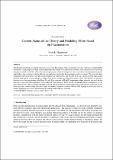Current status of the theory and modeling effort based on fractionation
Author(s)
Hagelstein, Peter L
DownloadPublished version (139.7Kb)
Terms of use
Metadata
Show full item recordAbstract
The theoretical problems associated with excess heat in the Fleischmann-Pons experiment were once viewed as insurmountable; nevertheless, some progress has been made in the past quarter century. Conceptually the problem can be split into one area involving new physics which is needed to address the microscopic physics of the reaction process; and a second area involving known physics which allows one to connect with the different practical issues involved in the experiments and observations. We review the ideas and progress first in the area of new physical mechanisms, in which models that describe the down-conversion of the large nuclear quantum allowing for coherent energy exchange of the nuclear energy into vibrational energy. These ideas provide a connection between excess heat experiments with Pd and Ni, with D or a mixture of H and D; experiments where tritium or low-level nuclear emission is seen, and other experiments with collimated X-ray emission. In the area of conventional physics mechanisms, we are interested in the basic physics of PdH and PdD; modeling cathode loading and understanding why some cathodes loaded very poorly in the early days; understanding active sites which we attribute to monovacancies in PdD and NiH; figuring out how active sites are created; triggering excess heat; and removing the helium made in the new reactions. Keywords: Excess heat; Fleischmann-Pons experiment; Karabut experiment; Mechanism; Theory
Date issued
2016Department
Massachusetts Institute of Technology. Department of Electrical Engineering and Computer ScienceJournal
Journal of Condensed Matter Nuclear Science
Publisher
International Society of Condensed Matter Nuclear Scientists (ISCMNS)
Citation
Hagelstein, Peter L. "Current Status of the Theory and Modeling Effort basedon Fractionation." Journal of Condensed Matter Nuclear Science 19 (2016): 98-109 © 2016 ISCMNS
Version: Final published version
ISSN
2227-3123